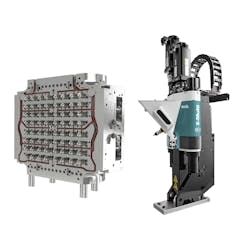Co-injection approach maximizes PCR use in small containers
By Karen Hanna
Molders seeking to incorporate recycled resin in their parts now can employ a Mold-Masters co-injection approach previously applicable only to relatively large containers.
The company's systems, which combine two different resins into a single three-layer melt flow, allow molders to match the amount of virgin material they’re using with as much as an equal part post-consumer recycled (PCR) material in the core of the part. This reduces costs, while allowing users and brand manufacturers to meet sustainability targets.
“Our co-injection hot-runner systems have individual temperature control that is separate for skin and core materials,” Igor Kim, the company’s global sales director for PET and co-injection applications, said in an email. “This allows materials with different melt temperature requirements to be co-injected and is often necessary when co-injection is used to inject barrier materials in a variety of packaging applications (core material is different than the skin).”
The systems, branded as the Connect package, include a co-injection hot half, process control technologies and an E-Multi auxiliary injection unit, which converts conventional injection molding machines to co-injection. In addition to the equipment, Mold-Masters provides engineering and start-up support.
Formerly available only for larger containers, such as 5-gallon pails, Mold-Masters’ equipment for PCR now works with part weights as low as 5 grams. In addition to applications involving PCR, applications using barrier and core materials can feature myriad other pairings, such as PET/nylon, PC/nylon, PET/ethylene vinyl alcohol (EVOH), cyclic olefin copolymer/EVOH, cyclo olefin polymer/EVOH and polylactic acid/polyvinyl alcohol. Mold-Masters systems also can process bioresins.
Typically, according to Mold-Masters, the process doesn’t increase cycle time. The hot runners give molders the flexibility to position the core where they want it, so PCR’s inferior material characteristics don’t compromise the final part.
In many cases, molders can reuse their existing tooling.
To compensate for the varying melt-flow indices of PCR and virgin resin, users of the equipment can adjust processing temperature.
“This added processing flexibility gives the operator enhanced process control,” Kim said.
Mold-Masters can supply thermally isolated manifolds that make it possible to combine two thermally different resins, but materials with similar melt temperatures are ideal for compatibility.
To accommodate smaller-part applications, Mold-Masters made modifications to the hot runners’ process control, as well as hardware components, including, for example, developing a smaller nozzle, Kim said.
The company’s equipment is applicable for all kinds of parts.
“If the package/part can be injection molded, it can be co-injected with PCR; however, part geometry can affect total PCR core content. To maximize core content, round, center-gated packaging shapes are ideal,” said Kim, who credits Mold-Masters’ control technology for providing the precision necessary to handle co-injection.
According to him, expansion of the hot-runner offerings comes as molders are increasingly seeking more-sustainable approaches to producing their goods, especially in Europe.
“We are seeing an increase in the demand for sustainable processing solutions. This is likely the result of a shift in consumer preferences in more sustainable choices and government mandates to improve sustainability in companies’ operations and the products they produce,” he said.
Karen Hanna, senior staff reporter
Contact:
Mold-Masters, Georgetown, Ontario, 905-877-0185, www.moldmasters.com
About the Author
Karen Hanna
Senior Staff Reporter
Senior Staff Reporter Karen Hanna covers injection molding, molds and tooling, processors, workforce and other topics, and writes features including In Other Words and Problem Solved for Plastics Machinery & Manufacturing, Plastics Recycling and The Journal of Blow Molding. She has more than 15 years of experience in daily and magazine journalism.
